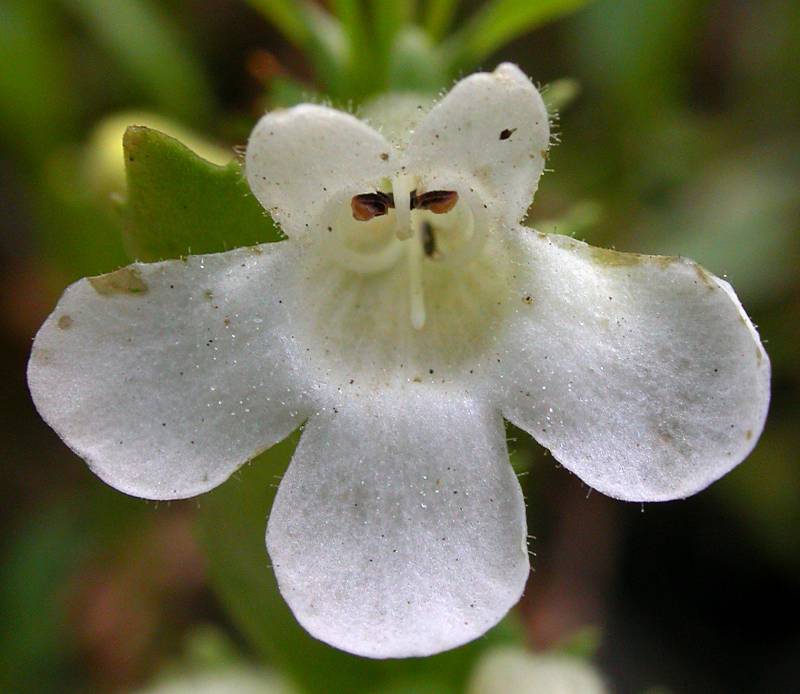|
egg-leaf beardtongue, broad-leaved penstemon
|
hot-rock penstemon
|
| Robust perennial from a woody base, the clustered stems 3-10 dm. tall, with stiff, spreading hairs below the inflorescence |
Plants with a much-branched, woody base, the flowering stems simple and erect, 2-6 dm. tall; plants usually glandular in the inflorescence, otherwise glabrous. |
Basal leaves opposite, clustered, petiolate, with ovate to sub-cordate blade up to 10 cm. long and half as wide, about equaling the petiole, serrate, hairy like the stem, especially along the mid-vein beneath; cauline leaves sessile and clasping, more sharply serrate, nearly as large, but more broadly oblong, the upper ovate. |
Leaves opposite, ternate, whorled or scattered, sharply toothed to entire; leaves on the short, sterile shoots oblanceolate to elliptic and short-petiolate, those on the flowering stems usually sessile and broad-based, up to 6 cm. long and 2.5 cm. wide. |
Inflorescence large and open, strongly glandular-hairy; calyx 3-5 mm. long, broadly lanceolate, with parallel veins; corolla blue, 15-22 mm. long, glandular-hairy on the outside, the raised portion of the lower petal pale blue and hairy; corolla strongly bilabiate, the lower lip much the longer; pollen sacs 0.8-1.1 mm. long, fully dehiscent and becoming opposite, nearly glabrous; staminode bearded toward the recurved tip. |
Inflorescence of several verticillasters, often rather loose; calyx 2.5-6 mm. long, the 5 segments lanceolate; corolla dull whitish with some purplish lines within, sometimes washed with lavender, 8-20 mm. long, the tube narrow; staminode glabrous or hairy, not expanded toward the tip; pollen sacs 0.5-0.9 mm. long, glabrous, dehiscent throughout, widely spreading. |
Capsule 4-6 mm. long. |
Capsule 3-5 mm. long. |
|
|
|
|
| May-August |
May-July |
| Open woods below 3000 feet in elevation. |
Open rocky roadsides, hillsides, and rock outcrops, sometimes in dry meadows, lowland to middle elevations in the mountains. |
Occurring on both sides of the Cascades crest in Washington; southern British Columbia to Oregon.
|
Occurring east of the Cascades crest in Washington; British Columbia to California, east to Montana and Utah.
|
| Native |
Native |
| Not of concern |
Not of concern |
P. acuminatus, P. attenuatus, P. barrettiae, P. cardwellii, P. cinereus, P. confertus, P. davidsonii, P. deustus, P. ellipticus, P. eriantherus, P. euglaucus, P. fruticosus, P. gairdneri, P. glandulosus, P. hesperius, P. lyallii, P. palmeri, P. pennellianus, P. procerus, P. pruinosus, P. richardsonii, P. rupicola, P. rydbergii, P. serrulatus, P. speciosus, P. subserratus, P. triphyllus, P. venustus, P. washingtonensis, P. wilcoxii |
P. acuminatus, P. attenuatus, P. barrettiae, P. cardwellii, P. cinereus, P. confertus, P. davidsonii, P. ellipticus, P. eriantherus, P. euglaucus, P. fruticosus, P. gairdneri, P. glandulosus, P. hesperius, P. lyallii, P. ovatus, P. palmeri, P. pennellianus, P. procerus, P. pruinosus, P. richardsonii, P. rupicola, P. rydbergii, P. serrulatus, P. speciosus, P. subserratus, P. triphyllus, P. venustus, P. washingtonensis, P. wilcoxii |
|
|
| |



